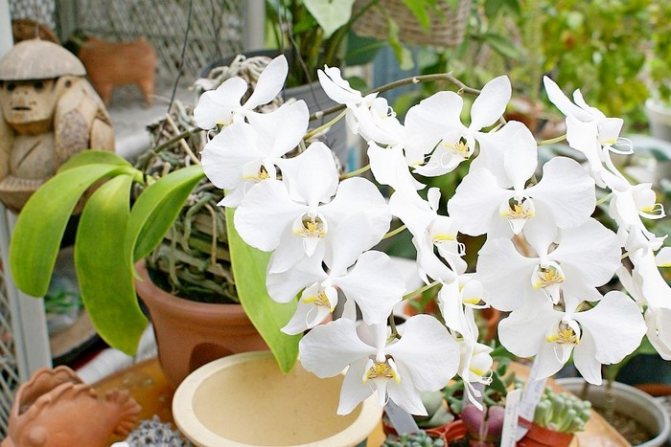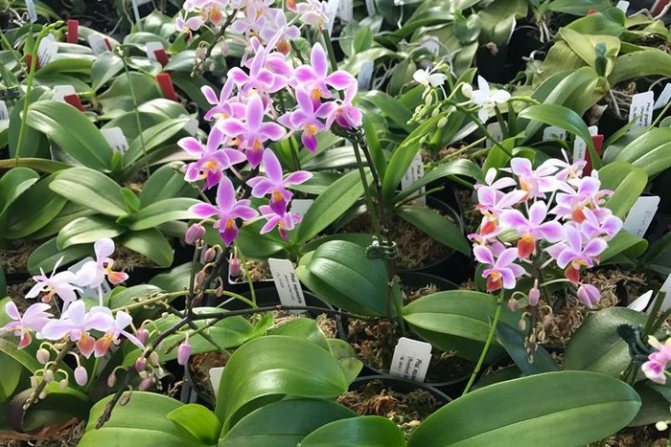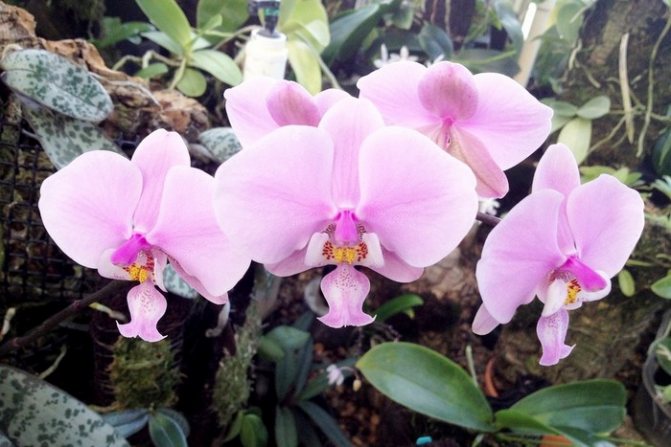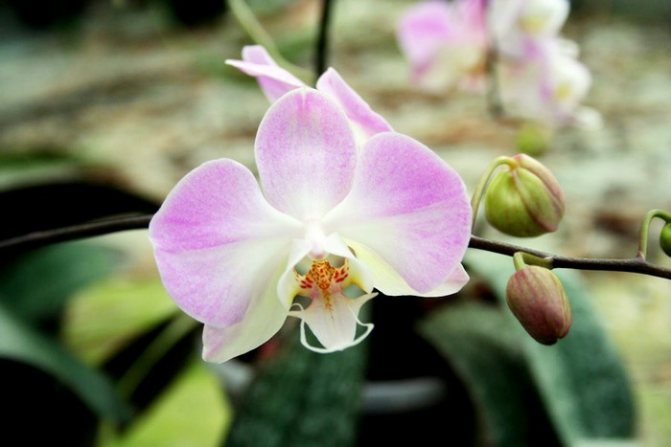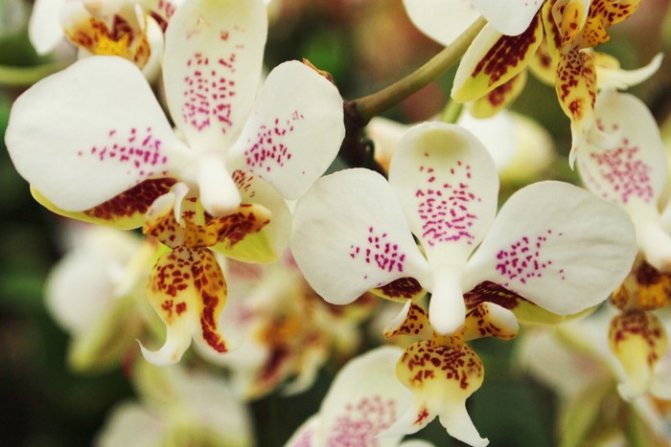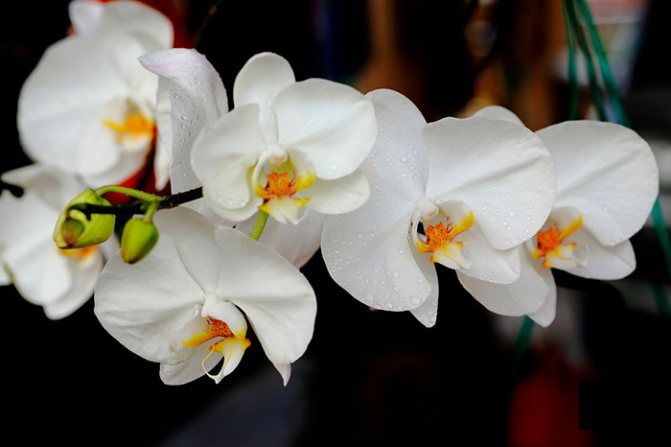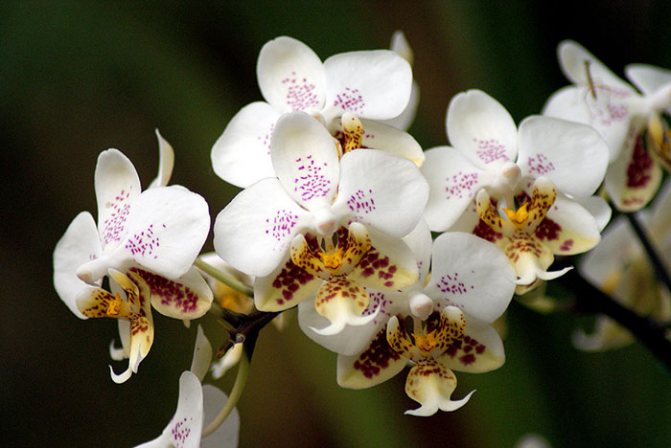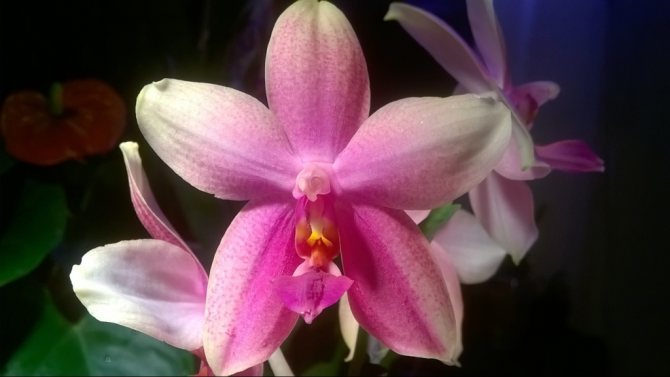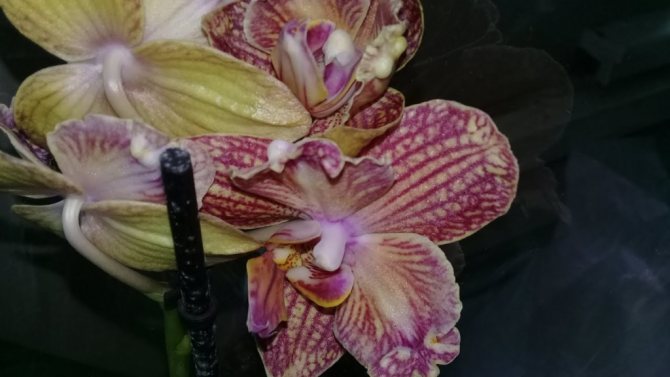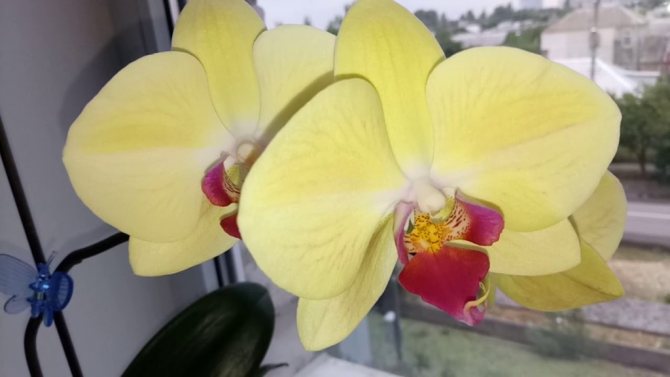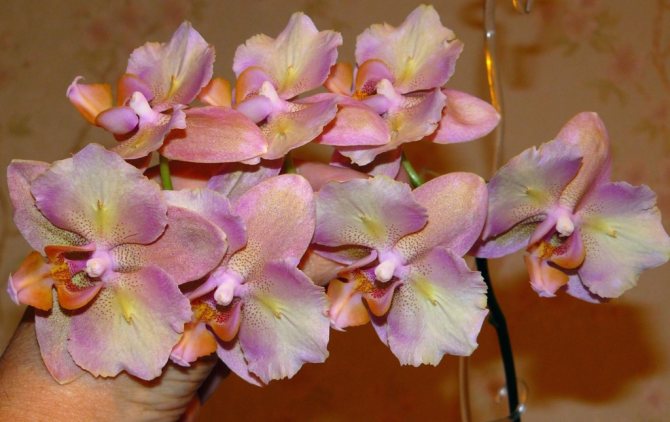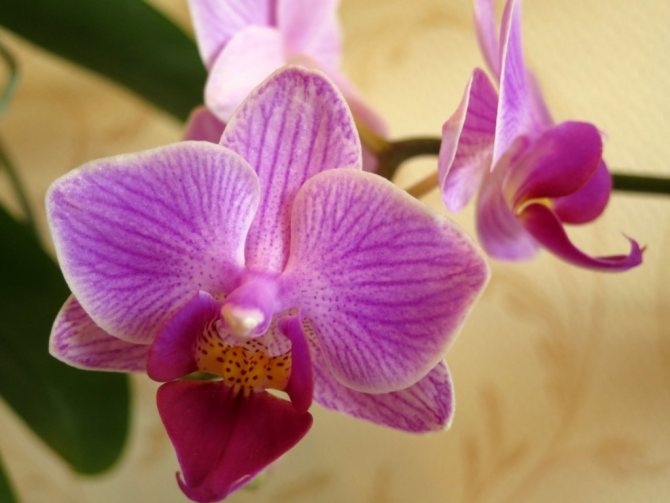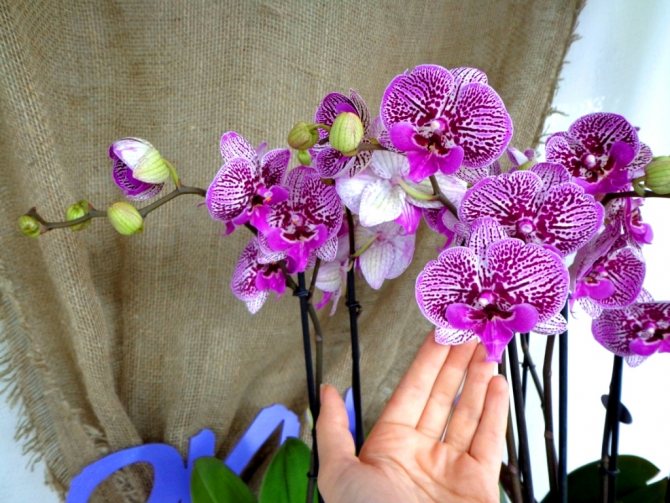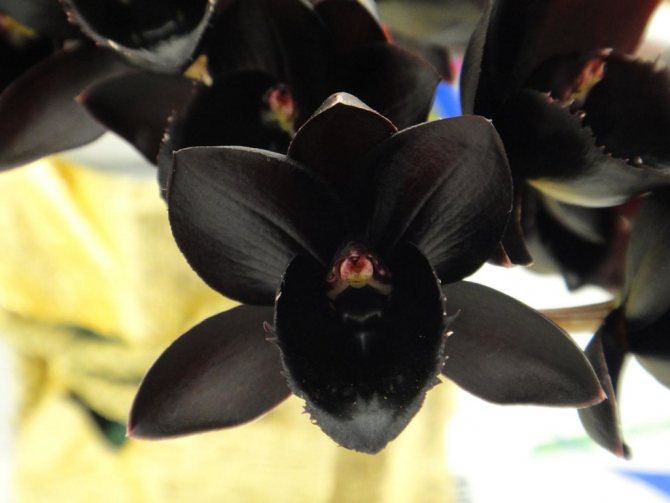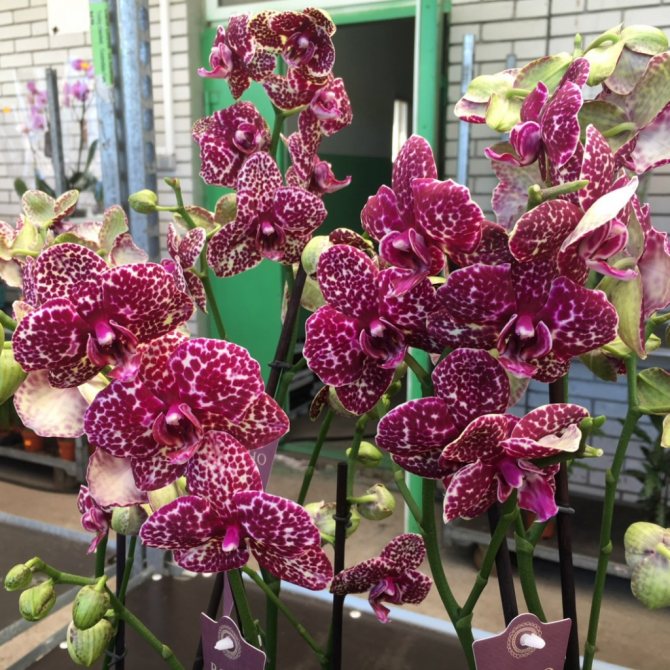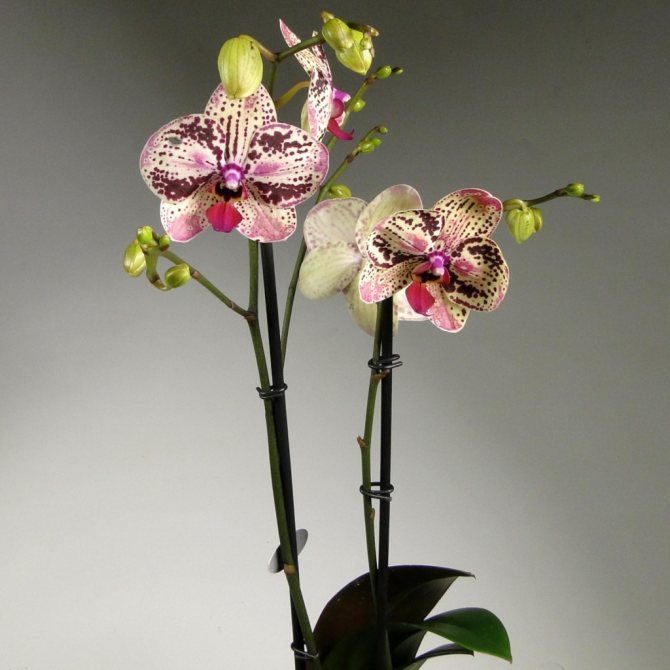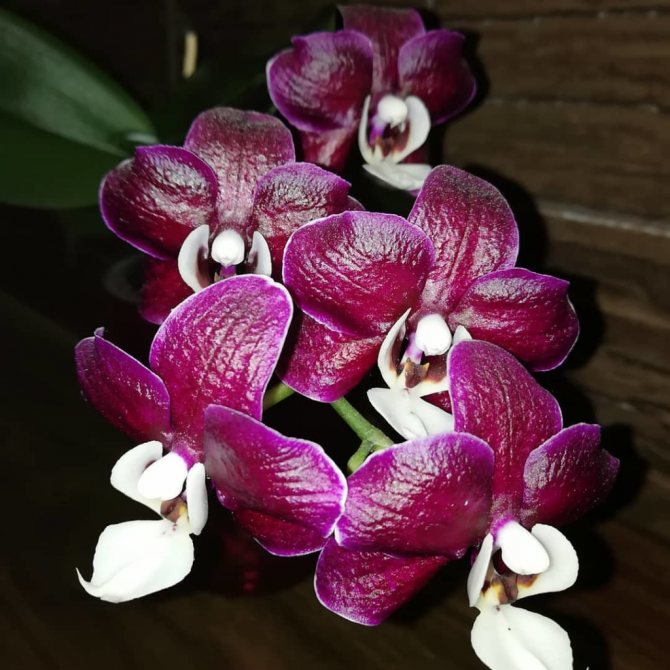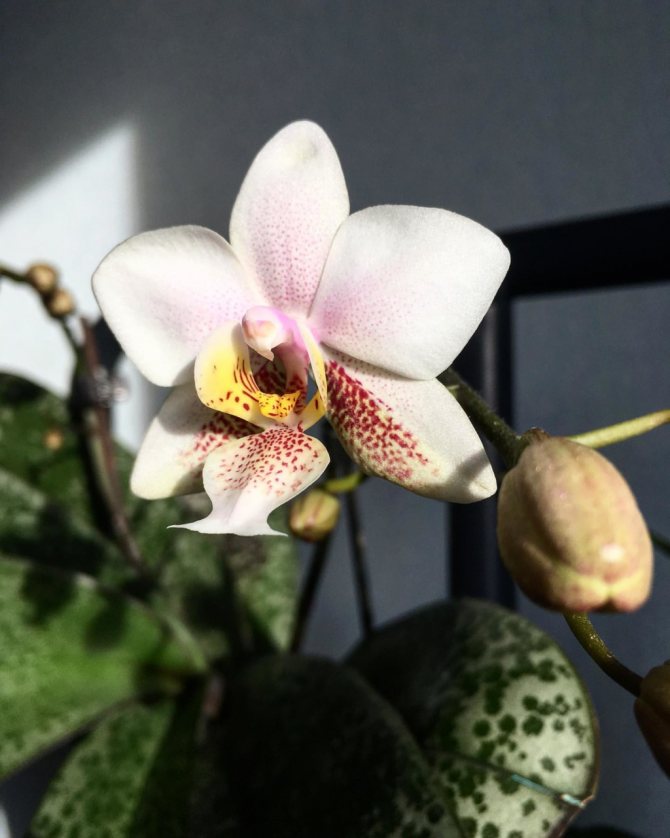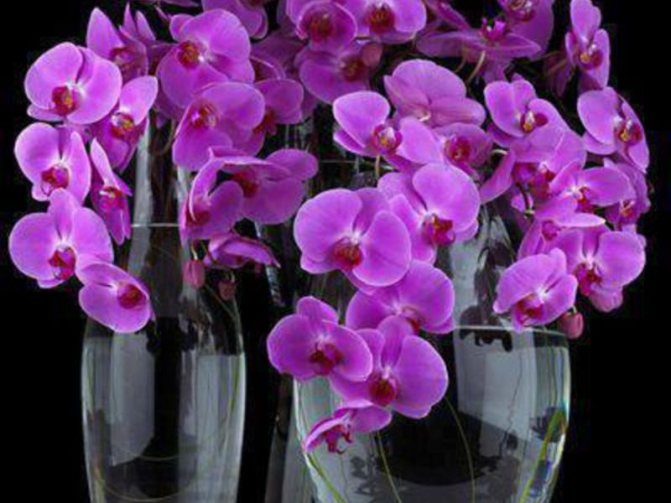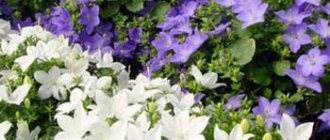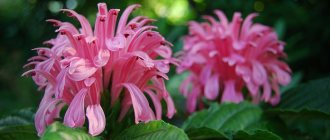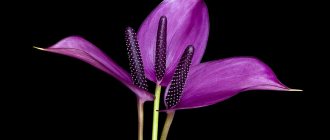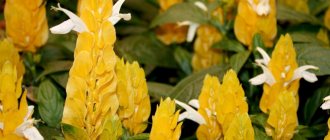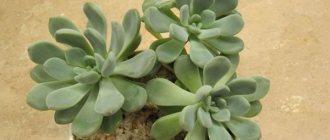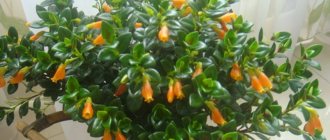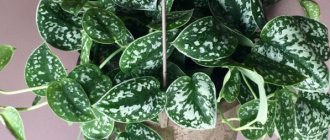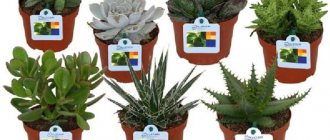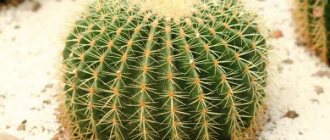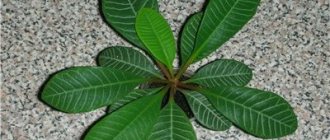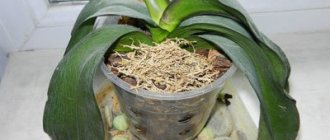General characteristics of Phalaenopsis orchids
Orchids are a huge family that includes many genera, representatives of which may look very different from each other. But any beginner can recognize phalaenopsis among them. These orchids are sold not only in specialized stores, but also in regular supermarkets. In general, the genus Phalaenopsis is characterized by the following general characteristics:
- Monopodial type of growth. This means that the plant has only one trunk and grows strictly in height, without forming a bush and pseudobulb. The single trunk of the phalaenopsis is short, the leaves on it are planted close to each other in two rows.
- Dense oval leaves of succulent type. The length and shape of the leaf plate of different phalaenopsis may differ slightly, but the leaf, in any case, will be fleshy, leathery, capable of storing a supply of water and nutrients.
- Well-developed epiphytic root system. Like all epiphytic orchids, phalaenopsis roots consist of a thin and very strong inner conductive vein, covered on the outside with a thick layer of velamen. Velamen is a spongy dead tissue of gray-green color, capable of absorbing water with nutrients dissolved in it, not only from the substrate, but also from the air.
- Long flexible peduncles with racemose or paniculate inflorescences. Peduncles in phalaenopsis are formed in the leaf axils with an average frequency of 2 times a year.
Flowers of different phalaenopsis differ in diameter and color, they can be more or less fragrant, depending on the variety. They are characterized by a rounded corolla, large rounded petals and sepals, and a medium-sized lip.
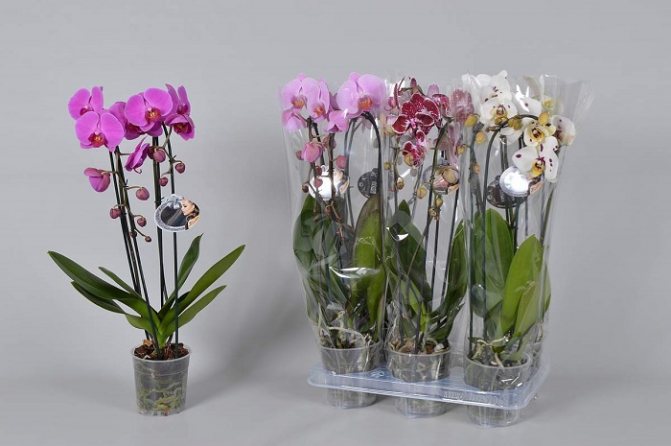
Phalaenopsis, which are sold in supermarkets in gift wrapping, are Dutch industrial hybrids that are produced for mass distribution and most often do not have a varietal name. Compared to varietal ones, they are very cheap, but they take root well in apartments and bloom regularly.
The most popular varieties of orchids
The most popular varieties of orchids with photos and names are presented in this section. But, before you deal with the varieties, it should be borne in mind that orchids are divided into the following categories:
- With bulbs. Bulba is a storage of nutrients, looks like a seal, which is often found in the lower part of the flower. This type includes: "Lelia", "Oncidium", "Miltonia", "Cattleya", "Dendrobium" and others.
- Sympoidal. This type of orchid grows in shrubs that have multiple shoots. The root system is horizontal. This type includes the following varieties: "Cattleya", "Cambria", "Oncidium", "Cymbidium".
- Smelling. Flowers have a wide variety of aromas, from harsh to almost imperceptible.
- Rare. The rarity of the orchid family is largely due to the flowers, which can vary in size and color. Many flowers resemble birds.
- Room. A lot of indoor orchids were bred, as they tried to make a home flower from an exotic plant. And I must say, it turned out pretty well. New varieties have taken root, although they require some attention.
We have also prepared a list for you, which is accompanied by pictures and descriptions to make it convenient for you.Let's take a closer look at one of the most beautiful flowers.
- Dendrobium. In nature, this orchid variety grows on trees, more often in trunks or branches. This flower is native to Australia, where forests and tropics are humid. Orchids of the genus "Dendrobium" are the most popular and have about 1200 species. These plants are small in size and their flowers vary in shape and color. A distinctive feature of "dendrobium" is its shoots, which are slightly thickened and have a cylindrical shape.


- Cymbidium. This genus of orchids can be found in flower arrangements, but the variety is rarely bred at home. The flower is easily recognizable by its xiphoid leaves. The flower stalk of the orchid is oblong and directed downward. The flower is quite sprawling, so at home it will take up a lot of space. Orchid flowers are small in size, and their color can be very diverse.


- Cattleya. The flower got its name in honor of the famous botanist William Cattley. This type of orchid also lives on tree trunks. This species has bulbs that are rather long and thickened in the middle. The leaves are compacted and leathery, their length is relatively short - 30 centimeters. Flowers are the hallmark of this species. The flowers are very delicate, lilac in color, and the "lip" is bright purple. Their color range ranges from whites to dark tones. This orchid variety has a scent.


- "Blue", or "Phalaenopsis aphrodite - royal blue". A chic representative of the orchid family (see photo). This hybrid was bred in Japan by crossing the "Asian Cammelina" and "Phalaenopsis Aphrodite". The orchid flowers are not very large, only 5 centimeters, and the leaves of the flower are wide and fleshy. It should be noted that this flower is difficult to buy, it is rarely found in flower shops.


- Miltonia. This member of the orchid family is one of the most popular among gardeners. Many hybrids have been bred on the basis of Miltonia. The leaves of this flower are large and oblong, and the flowers of this species have an aroma, while in some other varieties it is absent. A distinctive feature of Miltonia is long flowering.


- "Black Orchid". This flower is considered rare. The origin of the "black orchid" is still unknown to the end, so it is difficult to say something about this. However, all biologists and gardeners are eager to see a wonderful plant at least once. Peduncles of this species are oblong, but the leaves are short and dark.
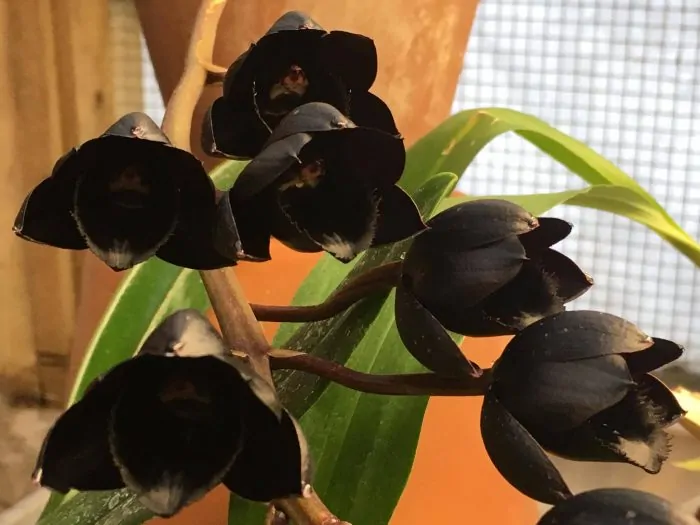

- "Cambria". This hybrid was bred specifically for indoor cultivation. The "cambria" has such a difference as a fusiform bulb, to which 2-3 dark-colored leaves are adjacent. Peduncles grow from the bulb, usually one or two shoots. The flowers are yellow with red or dark red dots. After the bulb has faded, it should be removed to form new flower stalks. If you properly care for the "Cambria", then it can delight with flowering all year round.


- "Wanda". This is a bush representative of the orchid family. Differs in its large size. The stem of the "vanda" is large, the leaves are xiphoid and oblong, and the peduncle is large. There are violet (different shades), pink, orange, red and white color of flowers.


- "Yellow Orchid". This indoor hybrid is bred specifically for life and breeding at home. The flower is small in size, has one stem and large fleshy leaves. The flowers are very delicate and beautiful, with a light aroma.
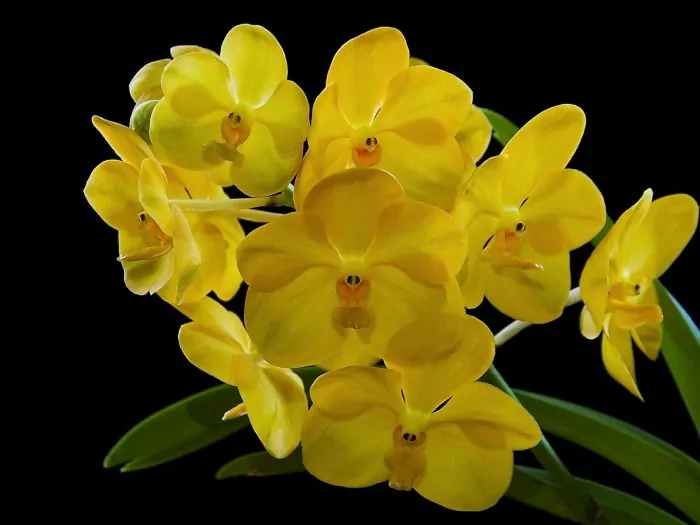

- Phalaenopsis mini. Based on the name, it becomes clear that the flower is small, for which many fell in love. This variety forms one or two peduncles on which many flowers bloom. The leaves of this orchid are small, however, like the flower itself.


- Dracula.A very interesting name and no less remarkable appearance of the flower. Peduncles of this species are large and look like the "mouth of a dragon".


- Bulbophyllum. The largest orchid variety in terms of numbers, which includes about 2 thousand subspecies. The leaves are large, fleshy, green.


- "Aganazia". A distinctive feature of this flower is its flowers and leaves, the latter are elliptical. Flowers (odorless) grow on the peduncle, which are in the form of stars. The base of the orchid is covered with small scales.


- "Angrekum". This orchid variety has a rather unusual branching type (see photo). The flowers are star-shaped and are quite large in size. It is worth knowing that some types of these flowers are not suitable for growing at home.


- Beallara. This hybrid was obtained by crossing four species - "brassia", "cochliodes", "miltonia", "onotoglossum". The stalks of "beallara" are dense, the leaves are elongated, with a clear vein in the center. The flowers bloom in the shape of stars and have a pleasant aroma.


- Brassavola. This variety was named after the Venetian botanist Antonio Brassavola. This species of orchid has fleshy leaves that form from a cylindrical bulb. Peduncles are long, with flowers at the end. It is worth knowing that this variety has an aroma that can only be felt at night.


- Brassia. Differs in large bulbs. The leaves are green and large. The main feature of this flower is the ability to bloom all year round.


- "Grammatophyllum". This representative of orchids is one of the tallest of its kind and can reach 60 centimeters. The plant's bulbs are large; flowers of light yellow color with brown spots grow on the peduncles.


- Zygopetalum. This type of orchid grows in a ladder, forming creeping shoots. Young bulbs grow slightly higher than the base of the previous one, which makes it possible to form a flower of an unusual shape. In pots, "zygopetalum" looks very impressive. The flowers are quite large, with a delicate and pleasant aroma.
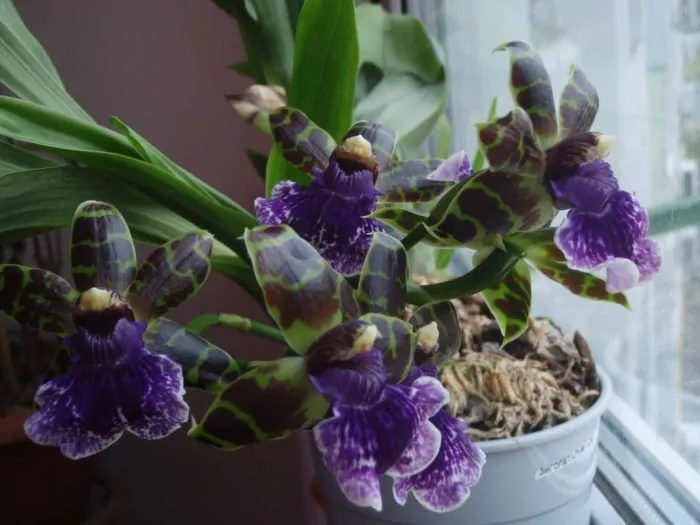

- "Katasetum". A very beautiful and original variety that includes about 150 species. Shoots are small and close to the soil surface. Bulbs are oval, leaves are pointed, with longitudinal veins.


- "Ludisia" or "precious orchid". This variety is distinguished by small, rather, small flowers. They do not look as impressive as large ones, but their scattering looks beautiful. The peculiarity of "ludisia" is its soft, even velvety leaves.
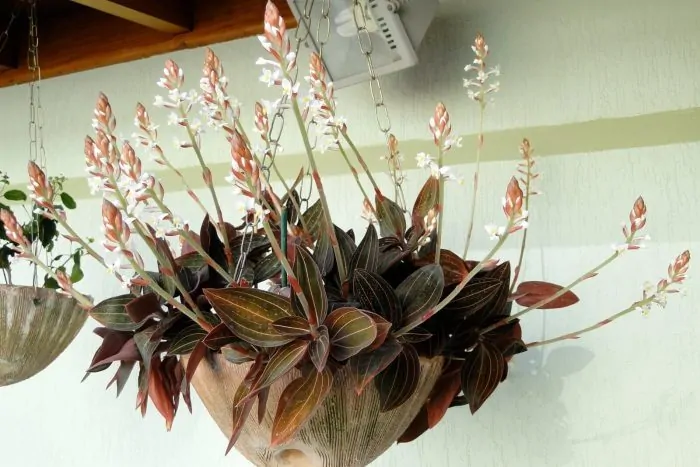

- "Miltassia" is a hybrid of "bracia" and "miltonia", which was singled out as a separate genus only in the middle of the nineteenth century. This flower is very difficult to confuse with any other species. The flowers are star-shaped, the petals are slightly elongated. The bulbs are flattened and slightly elongated. During the flowering period, an orchid can release several peduncles at once.
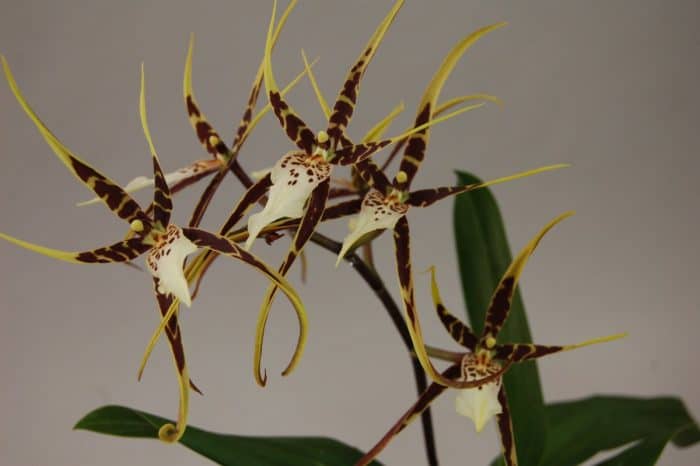

- "Oncidium", or "dancing dolls". The flower is characterized by long flowering. The flowers are small, lemon-red in color, although sometimes coral can be found.
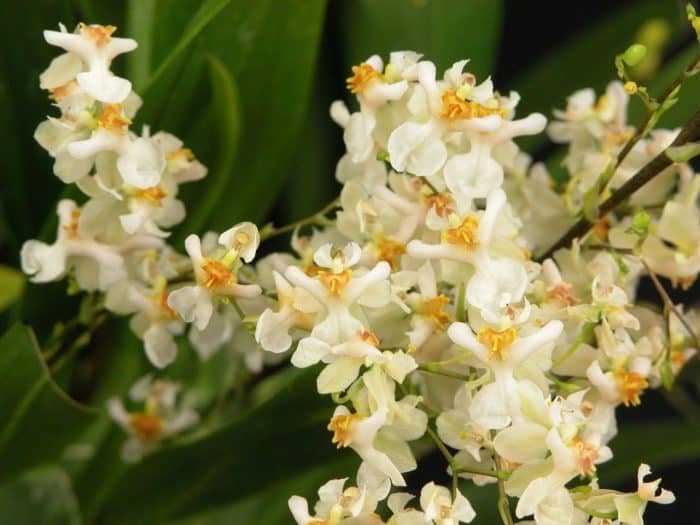

- "Tselogyna" is a fairly extensive type of flowers. This variety of orchids is distinguished by pale white or green flowers, which have a "lip" of a contrasting color.
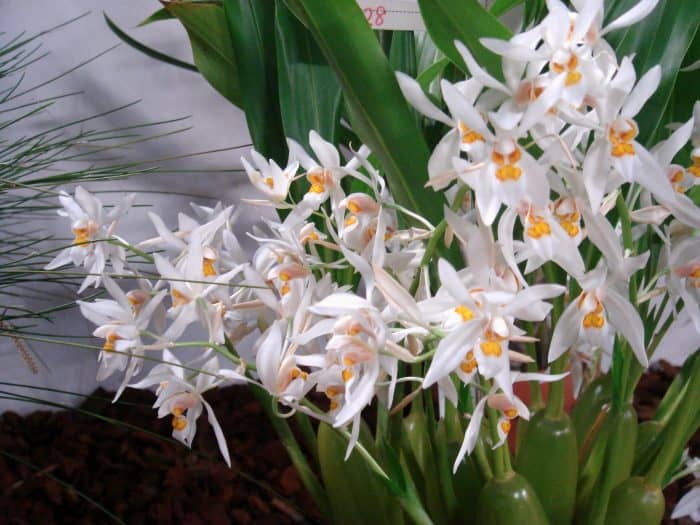

- "Pearl of the Emperor". This flower is quite large and has a lush bloom. The leaves of this orchid variety are fleshy, dense, oblong and green in color.
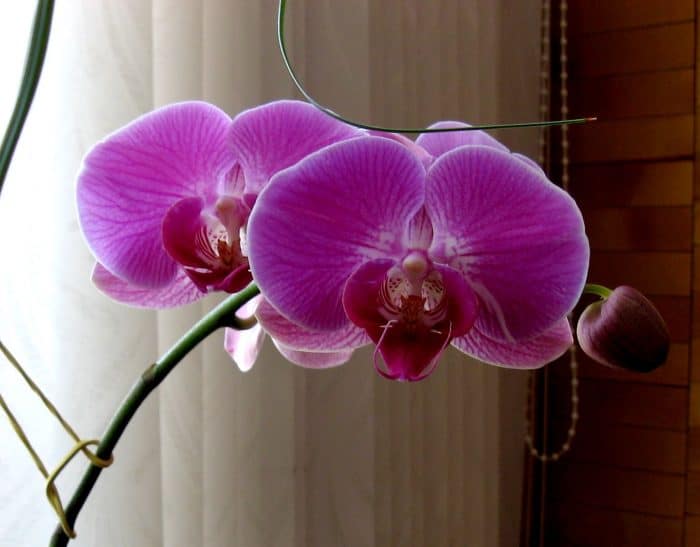

In this list, we talked about the most popular varieties of the orchid family. They are all beautiful, each flower is individual, has its own unique structure and flowering. Orchids are special flowers and require attention. In this case, care is required not only for the flower, but also for the leaves.
Phalaenopsis varieties: mini, midi, standard, multiflora, royal
Within cultural phalaenopsis, it is customary to distinguish several varieties that differ in size and abundance of flowering:
| Phalaenopsis variety | Features |
| Mini | Miniature hybrids with leaves 10-15 cm long and thin delicate peduncles about 20 cm high.It blooms with small flowers 3-5 cm in diameter. |
| Midi | Leaves are 20-25 cm long, peduncles grow up to 40 cm in height. The flowers are medium in size, 6-8 cm in diameter. |
| Standard | Leaves about 30-35 cm long, strong peduncles up to 60 cm high.The flowers are large, 10 cm in diameter. |
| Royal | A very tall hybrid with leaves up to 35 cm long and a peduncle height of 70-90 cm.They are distinguished by very large flowers with a diameter of 12-15 cm. |
| Multiflora | Phalaenopsis, characterized by the ability to form several peduncles at the same time, each of which willingly forms flower shoots of the second and even third order. They can be found among all groups of phalaenopsis, but are more common among the midi group. |
Among phalaenopsis, pelorics are often found - specimens with a modified corolla shape. However, this property is not fixed in generations, therefore, pelorics cannot be considered as some kind of separate group of orchids.
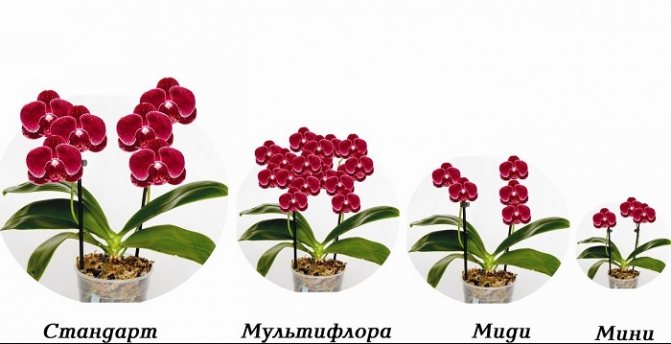

Looking closely at a phalaenopsis of any variety in an online store, it makes sense to get information about what size an adult plant will be. It is difficult to determine this from a photograph, therefore, if there are no special notes in the description, you need to focus on the diameter of the flower.
Orchid leaves and their varieties
Orchid leaves and their varieties are one of the criteria by which a flower is distinguished from others. Since orchids belong to the class of epiphytic (that is, they live on trees and feed precisely through them), their leaves take an active part in the process of life. Therefore, it is very important to take care not only of flowers, bulbs and root systems, but also of leaves.
Foliage for orchids plays a very important role, as this class of plants receives moisture, nutrients not only through the roots, but also through the leaves. The leaves also take part in the process of photosynthesis.
The strong and healthy leaf is dense and firmly attached to the stem. The color can be different: from light green to dark tones and variegated colors.
But sometimes the color of the leaves can change, and this is not always good, for example:
- yellow color indicates wilting (most often this is caused by improper watering and humidity);
- purple color is a burn, the flower is damaged by direct sunlight (in this situation, it is necessary to rearrange the flower to another place where the light will be diffused);
- red (brown) color of the leaves indicates that the plant does not receive enough sunlight;
- black (dark brown) color of the leaves may indicate that the plant is damaged by viral diseases.
To avoid many problems with the flower, it is necessary to properly care for the leaves. A daily inspection will help you notice any changes in advance.
Advice! Wipe them with a damp cloth. This will not only get rid of dust, but also give the flower the opportunity to absorb moisture. Try to use settled or purified water
The best varieties of mini-phalaenopsis
If there is not enough space in the apartment, and it is difficult to arrange a collection of large specimens of orchids, you should pay attention to mini-phalaenopsis. These miniature orchids are easy to maintain, they are easy to place under a phytolamp on a windowsill or rack, and in terms of varietal diversity they are not inferior to their tall counterparts.
Among the most popular and interesting varieties of mini-phalaenopsis, the following can be noted:
- Sogo Vivien. A miniature hybrid that is consistently included in all kinds of TOPs, thanks to the extraordinary variegated color of the leaves.Variegation in floriculture is called the variegated color of the foliage, and in this orchid it is manifested in the form of a light edging along the edges of dark green leaf plates
The flower of Sogo Vivien is very graceful, regular rounded shape, pale lilac basic color with dark veins. The lip is divided, three-lobed, dark lilac with a bright yellow highlight in the pharynx.
- Mini Mark. A hybrid famous for its abundant flowering and star-shaped corolla, which is not quite typical for Phalaenopsis. The color of the petals is white, speckled. The specks are small, orange, reminiscent of a scattering of freckles. The lip is expressive, like a tongue, three-lobed, dark orange in color.
In the assortment of mini-phalaenopsis, the Kolibri cultivar group attracts attention, including the varieties of Russia, Columbia, Brasil and others.
Caring for miniature phalaenopsis is no different from caring for "tall" specimens. However, great care must be taken with them with all standard manipulations. Fragile peduncles and roots of "babies" break easily.
Important! Mini phalaenopsis are often sold in pots filled with clean moss. It is highly advisable to transplant the plant into a mixture of bark and moss to eliminate the risk of flooding. If the purchased specimen blooms, you need to wait until the end of flowering before transplanting.
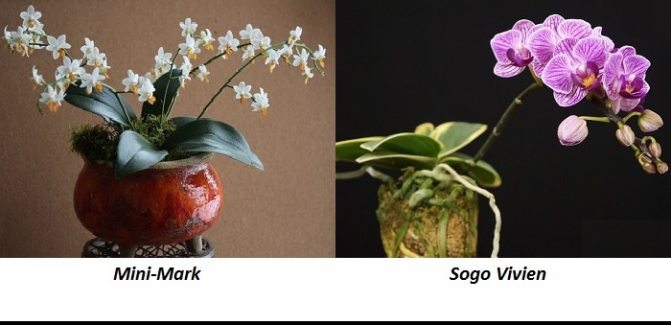

For transplanting mini-phalaenopsis after purchase, pine bark must be taken in fine fractions. The ratio of bark to moss should be 1: 1. It is impossible to transplant miniature phalaenopsis directly into a clean bark.
How to care for a flower?
These varieties can be installed on the western and eastern windowsills without even using greenhouses, in the summer at a temperature of + 24 ... + 29C, in the winter - at least + 14C. A decrease in temperature at night stimulates the appearance of buds of inflorescences. On cold, cloudy days, it is best to arrange additional lighting.
During growth in the summer, it is necessary to spray the flower every day. These plants will only bloom at humidity 60-85%... You can increase the humidity with a humidifier, or you can place the flowers on a tray filled with damp gravel.
If the capacity where the orchid grows becomes small, and the growth of the flower has decreased, then this means that it needs to be transplanted. As a rule, the transplant is done no more than once every 2 years. It must be done quite carefully so as not to injure the delicate roots. It is advisable to cut or break the old container, and place the plant together with a lump of earth in a new container, adding soil.
These types of orchids need a special substrate, plain earth will not work. You can do it yourself: pine bark, charcoal and sphagnum. Under natural conditions, plants grow on trees. Roots provide them with water and minerals, therefore they need a lot of air. The larger the substrate, the better. In addition, it is advisable to choose transparent plastic pots for cultivation, where holes for drainage can be made.
When choosing a flower, pay attention to its root system. The roots must be green without any rotting or dryness. No need to worry when some of the roots come out of the pot. During the purchase, carefully inspect the flower: the main thing is a well-formed rounded inflorescence, it should not have any damage.
Probable problemsthat appear during cultivation:
- the plant has sluggish leaves - most likely, the reason is in the very dry air. Flowers with a pot must be dipped in water for a couple of hours;
- the plant has stopped growing - the flower is at a low temperature or overdried. The reason may be an untimely transplant (you can only transplant when new roots are formed);
- rotten roots - this is the cause of severe waterlogging. A clod of earth with roots must be thoroughly dried. Then do not water the flower while there is condensation in the pot;
- pests - can be infected with a scabbard or spider mite. Maintaining high air humidity is the best preventive measure. Spray the plant frequently. To remove ticks, you need a diccofol-based acaricide;
- dried up roots - when the dried root system gets brown, despite sufficient moisture in the soil, this means that the flower is "overfed", salts have accumulated in its cells;
- burn spots on the plant are the result of exposure to the rays of the sun, cover the pot;
- the plant does not bloom - the reason is improper care, but if the flower was outwardly healthy before, then most likely it is a lack of light.
Orchid propagation
Usually, propagated by dividing the plant, it is cut with a knife into several parts, so that each has its own roots. Often dormant buds are formed into babies, they are transplanted after the formation of their roots. You can also propagate the plant by seed. Orchids that are grown from seed usually bloom the next year.
Phalaenopsis midi: description of interesting varieties
Midi is a very large and demanded group of phalaenopsis. These are quite strong, disease-resistant plants, easily adapting to the conditions of detention.
Medium-sized phalaenopsis are represented by a large assortment of varieties and hybrids. Of particular note are the following:
- Black berd (Black bird). A plant with an unusual dark cherry color of the corolla, which appears almost black in certain lighting conditions. The corolla is rounded, but the petals are slightly narrower than those of most phalaenopsis. In the flower, a small white-pink column stands out in color, giving a bright glare against the general dark background.
- Miki Tipsy "86". A spectacular Thai hybrid with a large flower for the midi group with a diameter of 8 cm. Corolla shape is correct, rounded. The color is tricolor, the main background is the colors of creamy ice cream. At the base of the sepals and petals there is a blurred pale lilac spot, and along the edges there are dark burgundy strokes.
Phalaenopsis of the midi group are in the price range between mini-phalaenopsis and standards. Plant care is standard, it has no special features.
“I prefer to deal with midi-phalaenopsis. They are compact, unpretentious, do not require huge supports for peduncles, it is convenient to place supplementary lighting ”(Natalya, Samara).
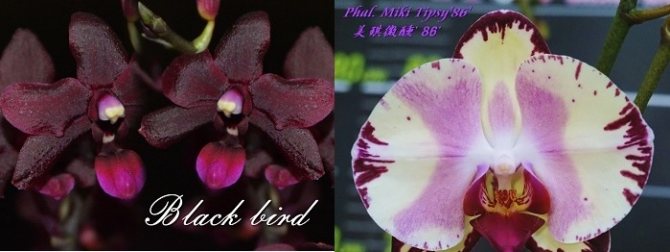

Interesting varieties of medium-sized phalaenopsis can be ordered through groups in social networks. Joint purchases are often formed there, allowing you to save on delivery.
Flower types
Classification of varieties is not as difficult as it seems at first glance. There are two methods:
- The first is based on the principles of taxonomy, where the general nomenclature of varieties is based on Grex and their pedigrees. It is used by professionals.
- The second method is consumer classification according to visual characteristics and type of flowering. Strictly systematic and indirectly takes pedigree maps into account. Suitable for amateur and novice florists. Consumer classification divides phalaenopsis varieties (by flowering type) into three groups.
Standard
Long peduncle with flowers on the upper half. Large flowers from 9 to 12cm. The apical bud, at the end of the peduncle, dies off after flowering.
A peduncle with a dead bud is cut off.
Multiflora
The peduncle branches densely and grows during flowering. Small flowers from 3 to 6cm. Sometimes differs from standard phalaenopsis in the shape of the flower.
Novelty-phalaenopsis
They have a long flowering time. Their peduncle grows many times from the apical bud. Variegated flowers (4-9 cm) of regular shape, with ovoid or pointed petals.
The apical kidney does not die off. The peduncle does not need to be cut off after flowering. New buds will appear later.
Novelty-phalaenopsis is the most interesting group with the highest collectible value. Additionally, it is divided into two parts:
- Classic novelty-phalaenopsis. These are varieties with pedigrees only between natural species. Star-shaped flowers, pointed petals. The size of the flowers is from 4 to 6cm. They breed well with each other.
- Modern novelty-phalaenopsis... Varieties with pedigrees between natural species and standard phalaenopsis. They have the correct shape of flowers with ovoid petals. Larger than the classic ones - from 5 to 9 cm. Different breeding ability.
Each plant variety requires an individual approach to the conditions of its maintenance.
The best varieties of Phalaenopsis standard
Phalaenopsis of the standard group are preferred by connoisseurs of large-flowered orchids. There are a lot of popular varieties, but the following ones draw special attention to themselves:
- Wild cat. It is appreciated for its spectacular "leopard" flowers - cherry spots on a creamy background. The diameter of the flowers with good care is about 10 cm, with a lack of light - 8 cm.
- Breezes (Parrot, Bee Sting, Elegant Charm Age)... An orchid with a strong trunk and powerful foliage, which has a magnificent bright yellow flower with purple streaks along the edge. The lip is bright lilac with a yellow tongue in the pharynx. Diameter 8-10 cm.
Standard Phalaenopsis have very strong and flexible peduncles. Therefore, despite the fact that the arrows are very long and the inflorescences are heavy, they can be grown without a garter to a support.
Tip # 1. Many collectors allow standard Phalaenopsis shooters to bend or hang down freely. This method of growing is convenient because it does not force the phytolamps to be raised high during flowering.
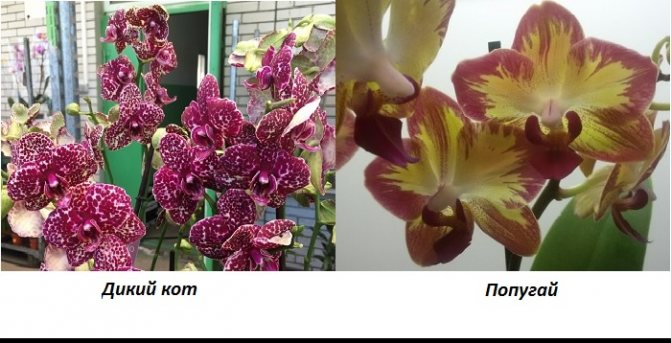

The effectiveness of the flowering of phalaenopsis standard largely depends on the lighting. Without artificial supplementary lighting, winter flowering is usually less abundant, and the diameter of the flowers is small. To obtain large flowers, installation of phytolamps is desirable.
Growing recommendations
Blooming orchids are simply gorgeous and can be used to decorate any room. Hybrids can have flowers at any time, twice a year. On a large (up to half a meter) peduncle up to 14 inflorescences are formed... The colors are very different, there are types with orange, green, marble, yellow and other colors. A flowering plant indoors is sure to become the main focus. A beautiful flower speaks of a well-groomed home, where peace and understanding prevail.
The blooming plant does not attract much attention in the living room, where the flower is surrounded by books, photos, paintings, decorations, etc., but it cannot be overlooked when it is alone on the coffee table in the hall. Having appeared, once in your home, these flowers will turn into full-fledged family members over time. Naturally, they cannot be considered a regular part of the design. Finding an orchid in phytodesign as the main element implies the choice of other elements of the composition, corresponding to vases, souvenirs or photos on this topic. Phalaenopsis - Great for pruning. A cut flower can keep freshness for a month.
Room microclimate
Graceful shapes of stems, original contours of leaves, fresh greens, flower buds. All this affects a person as the strongest psychological factor of calmness, self-affirmation and at the same time relieves stress and normalizes the nervous system.
Energy
This flower is perfect for creative individuals. Its graceful curves, the beauty of a flower can awaken inspiration even in an inveterate "techie" and make them make their little creation. In addition, the plant itself allows great opportunities for creativity: you love to draw - it will give you great pleasure to draw a flower, you like to take a photo - choosing a background, an angle and setting up lighting for this will take more than one amazing hour.
Energy characterized by rotational vibrations that are directed outward. Energy moves in a spiral from the middle of the flower with increasing circles. It has an exciting effect, gives strength, because plants with this energy do not need to be combined with flowers that emit cloud-like vibrations.
An orchid is a flower that will require careful maintenance. With the right approach, this plant will be able to please the owner with refined and elegant inflorescences for many years. The more attentively the care takes place, the longer the flowering time.
Royal Phalaenopsis: a spectacular variety
Royal Phalaenopsis is a powerful plant whose flowers are capable of covering a woman's palm. There is very little information about the varieties of this variety, and most often orchid collectors acquire such phalaenopsis by accident, sometimes even at a markdown.
One of the rarest and most spectacular varieties of royal phalaenopsis is Green Apple. In addition to the fact that the flower of this variety itself is huge, so also the flowering of this orchid is "cascading" - with a heavy falling brush. The color of the flower has the following characteristics:
| Part of a flower | Characteristic |
| Sepalia | Large, rounded, light green color. |
| Petals | In the shape of a butterfly wing, snow-white. |
| Lip | Neat, three-lobed, white with a light green inner surface, pinkish speckled throat and two expressive antennae. |
Usually, in royal tall phalaenopsis, flower arrows are very thick, reaching 1 cm in cross section.It is this feature that allows the plant to endure a serious weight of flowers during flowering.
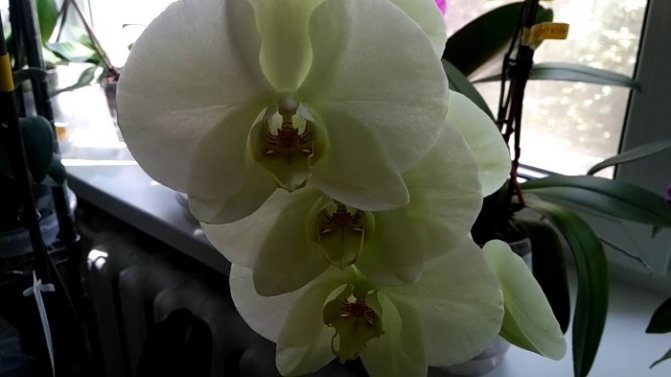

Despite the strength of the peduncles, in the midst of flowering royal phalaenopsis, it is better to place the arrow on a support.
Amabilis
So, now let's go directly to the consideration of photos and names of phalaenopsis varieties. The first will be considered Amabilis, or Pleasant variety. In the wild, this flower grows in Australia, but now it is more often found on home windowsills. It is relatively unpretentious, so it is quite easy to grow it.
This flower has large oblong leaves, there are 4 to 8 of them in one plant. They can grow up to half a meter in length, but this rarely happens at home. It was from this orchid that many hybrids were subsequently bred, therefore breeders often use it in their research.
It is worth remembering that this flower can only be white. They are usually large - up to 10 cm in diameter, and up to 20 flowers can form on one peduncle at a time, although they usually open gradually. Amabilis will delight its owner with flowers for a very long time - usually his flowering period lasts up to 4 months with proper care.
The best varieties of multiflora and features of their care
All of the listed groups of phalaenopsis can be multifloras. For example, the royal Green Apple with cascading flowering, in fact, can be classified as a multiflora.
Sogo Yukidan is the most popular among other "cascades". This phalaenopsis forms long garlands of snow-white flowers, the length of which can be up to half a meter.
However, the multiflora includes phalaenopsis not only of cascading flowering. Any variety that is capable of branching a peduncle well and releasing more than one arrow at a time can be considered multiflora. For example, such orchids include varieties:
- Brown Sugar. Phalaenopsis with a purple-brown flower, the petals of which have a snow-white edging.
- Dragon. Phalaenopsis with a rounded peach flower with a delicate dark speck at the base of the petals.
- C * 322. Phalaenopsis with a pale pink base color of the corolla, covered with large scarlet specks.
Multiflora needs good care, otherwise it will not be possible to achieve abundant flowering. Particular attention should be paid to feeding.The introduction of phosphorus-containing fertilizers during the growth of the peduncles will allow the plant to form a large number of viable flower buds.
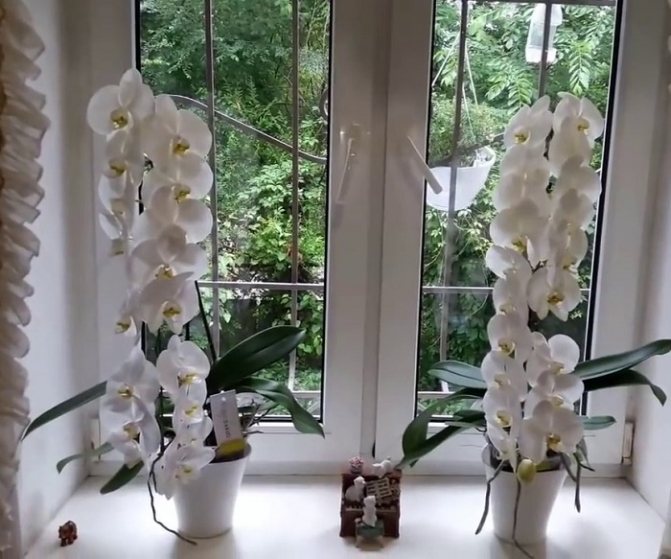

Home flowering of cascading multifloras differs from greenhouse flowering, but still remains impressive. Top dressing and intense lighting help to increase the number of flowers or enhance the branching of peduncles.
How do plants differ?
In nature, there are about 75 species of orchid of the genus Phalaenopsis. They are distinguished by:
- the size of the leaves;
- peduncle height;
- the shape and color of the petals;
- flowering duration.
The simplest principle for classifying species is conditional division into groups:
- A group of phalaenopsis with long peduncles and branched inflorescences, large, rounded flowers of pink and white tones.
- Phalaenopsis group with flowers and waxy petals of various shapes and colors, short peduncles.
Cross-pollination of species has resulted in a wide variety of varieties of varied sizes, with flowers of the most incredible shades.
Many indoor phalaenopsis are derived from the Amabilis cultivar.
What is interesting in the genus Phalaenopsis
Scientists believe that the flora was first enriched with orchids of this genus in the south of China. They are accustomed to a warm climate with night temperatures of at least 21 degrees, with an air humidity of 50% or more. Almost all of them are epiphytes, do not require a dormant period and can be grown in block culture - on pieces of pine bark. All types of phalaenopsis are characterized by:
- the presence of only one growth point on a highly shortened stem;
- aerial roots covered with a moisture-retaining layer of cells;
- multiple flowers on beautifully curved stems;
- often strong, but not always pleasant;
- dense leathery leaves.
Attention! The roots of epiphytic plants, by their nature, cannot always be in a humid environment. For this reason, phalaenopsis needs to be dried between watering.

